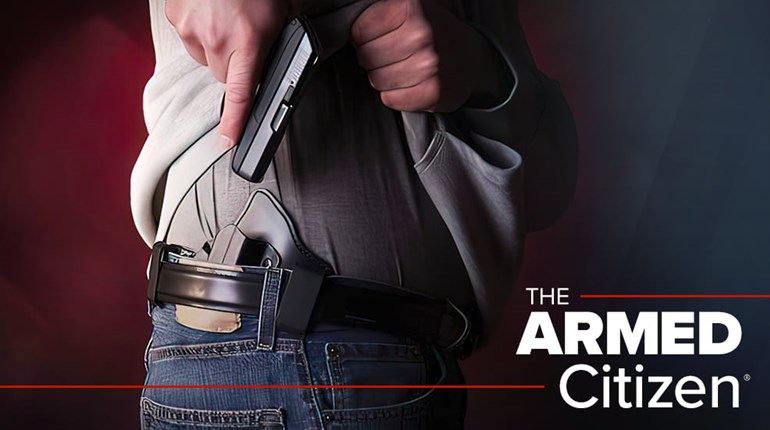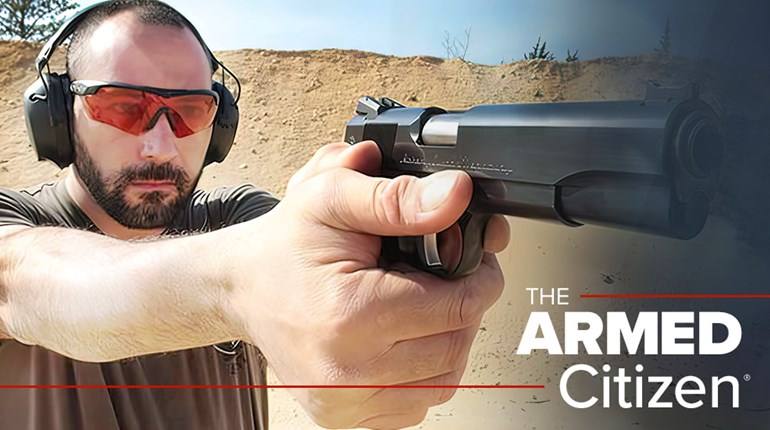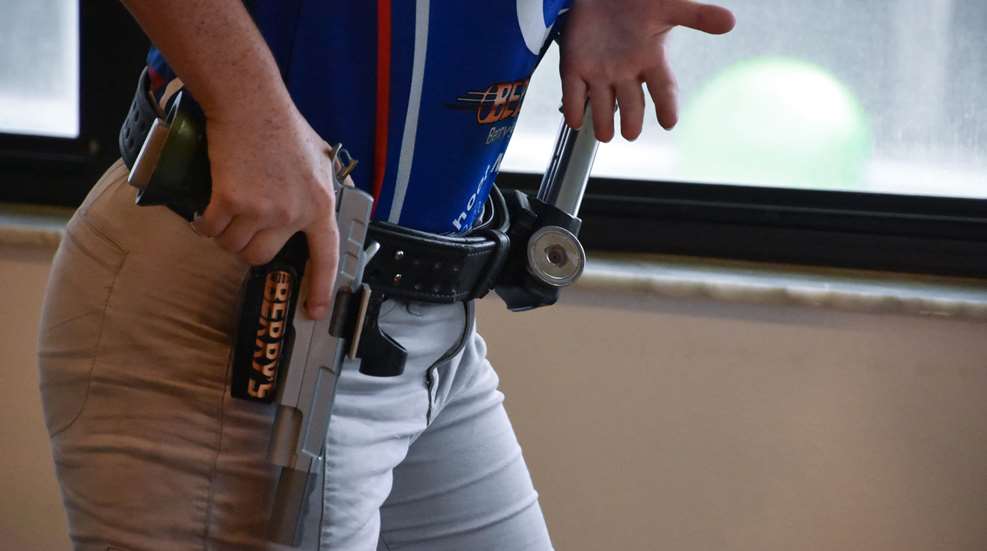
There are times that making it to the range to train with a firearm doesn’t fit into life’s hectic schedule, or we can’t track down the ammo we need. Although dry firing may sound silly, it can help you build certain skills without a trip to the range.
What is Dry Fire?
Dry firing is the act of manipulating the firearm and pulling the trigger without ammunition. It gives you an opportunity to practice the skills needed to use your gun without using live ammo or making a trip to the range. You can do it just about anywhere. A session a week will help you stay proficient in skills like your draw and acquiring proper sight picture. Several sessions of intense focus on a single skill will help you develop the muscle memory required to learn and improve.
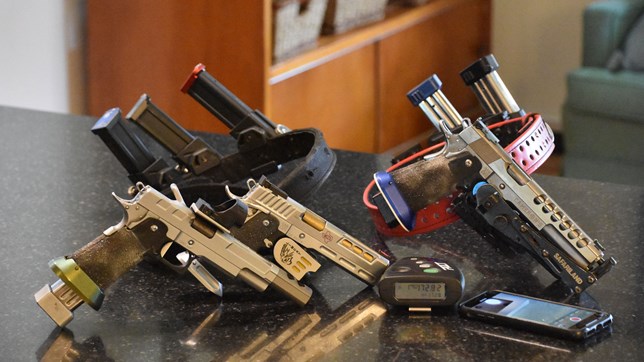
Competition guns can be dry fired as well as concealed carry guns. A timer and a phone or camera to video yourself will help you see your progress and understand where you need to focus your efforts.
The history of dry fire as an efficacious means of practice with a firearm is well-established. Olympic medalists used dry fire practice when their range access was limited during quarantine. But you don’t have to be an Olympian to take advantage of this free tool. You just need to know how to do it properly and be willing to work.
Before You Start
The first thing you need to know is that dry fire involves a firearm, so you still need to follow the rules of firearms safety. If you are going to dry fire your concealed-carry firearm, unload it at your safe or in a separate place from where you dry fire. Visually and physically check that the firearm’s chamber is clear. Remove all live ammunition from the room in which you will do your practice (yes, that is standard operating procedure for all shooters). Then take your empty gun, empty magazines, holster and whatever gear you plan to use to your designated dry fire location.
Be sure to know your target and beyond, and treat your gun like it’s loaded. This means choosing a safe direction to dry fire. For example, avoid any inner walls where a person could be sitting on the other side. I often use the foot of my bed so magazines can drop quietly, or the arm of the couch, facing an outer wall.
Special Attention if You Own a Rimfire Firearm
If you have ever heard, “Don’t shoot an empty gun. You’ll damage it,” you heard that correctly, but only for a specific type of gun. The guns that you don’t want to dry fire are rimfire guns, like rimfire .22s. A rimfire firearm is designed so that the firing pin hits the rim of the shell casing. Some people put a “snap cap” or dummy round in the chamber, but the long-term effects of dry firing a rimfire can cause damage. If the caliber is larger than .22, dry-fire practice is safe for the gun.
The Draw
Your draw is arguably the most critical in a defensive situation, and your speed in competitions will suffer if it is not done correctly. I recommend setting up a camera or phone to record your practice, as well as a timer to keep you on track.
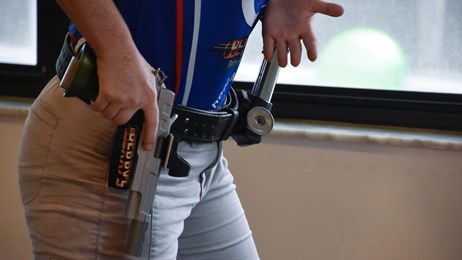 The first step in dry fire and working on your draw is moving your hand to the gun.
The first step in dry fire and working on your draw is moving your hand to the gun.
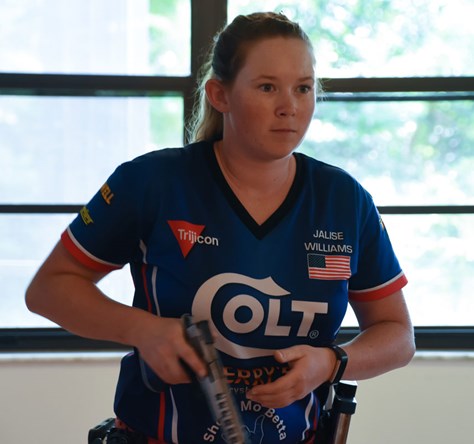
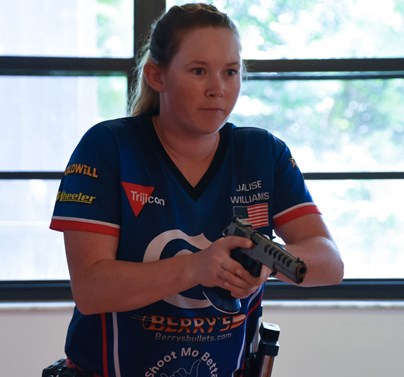 The next step is building your grip after your hands meet in front of the gun and pressing the gun out from your body as you acquire the sites.
The next step is building your grip after your hands meet in front of the gun and pressing the gun out from your body as you acquire the sites.
When you practice your draw for competition, you generally measure it based on your first shot on target. How fast that is will depend on target size and distance. You can set a par time on a timer to measure how long it takes to break your first shot with dry fire. Set it at something reasonable like 2.5 seconds to draw, bring up the gun, align your sights onto the target, squeeze the trigger, and break the shot. Lower the time as you improve your muscle memory. It takes about a thousand repetitions of a movement to build that muscle memory, because you are literally forging a physical connection from your brain to your muscles.
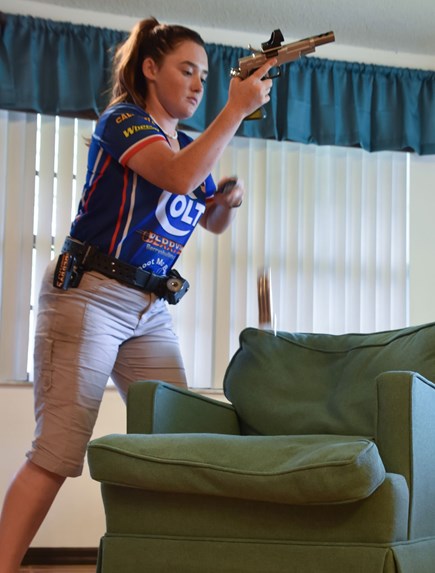
However, practicing a bad draw over and over again is going to do you more harm than good. I would advise first learning from an instructor or at least researching the proper form through videos. As you’re building muscle memory, you want to build it perfectly. Perfect practice makes perfect performance. So to get to the point where you can execute a fast and technically correct draw, start slow, repeat it properly and the muscle memory will come with time.
A draw from concealed carry is going to differ from a competition draw. You will need to account for a multitude of other variables. Are clothes concealing your gun? Will you need to remove it from a purse or bag? This will add time to your draw. Are you often seated at a desk or in a car? You may want to practice a draw from that position as well. Practice your draw under the same conditions you would actually have to draw your firearm.
Dry firing is a great way to practice your draw because it gives you the opportunity to fix issues before practicing an incorrect draw 100 times. Remember that camera I recommended? Use it, and be sure to critique yourself after each attempt. Did you sweep yourself? Does the concealment garment or bag work? Would you “flag” others if you were to draw in public? These are real considerations that you can work out with dry fire.
Other Dry-Fire Skills to Practice
After the draw, work on watching what happens in your sights as you break the trigger. Dry fire can tell you what happens after you pull the trigger in a way that live fire doesn’t because of the recoil. Without distracting recoil, you might see the sights move or muzzle dip. This is information about how you just pulled that trigger. You want to break the shot without moving the sights.
Once you’ve established a good draw and first shot, work on other skills, like a magazine change or moving the gun from one target to another (transitioning). The more skills you can automatically execute because you’ve practiced until they are muscle memory, the more your brain will be free to take in what’s going on around you while you are shooting. In competition, that might mean finding your next position or calling your shots. In a self-defense scenario, that might mean being able to see and identify what’s in someone’s hand while you are readying your firearm.
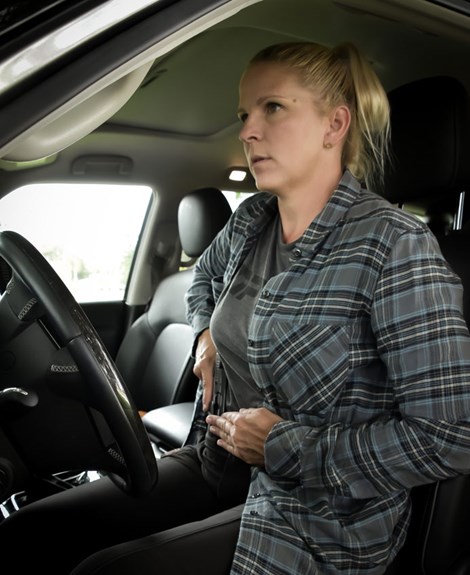 Dry firing from a vehicle or other position that you might need to draw your concealed carry gun from is a good way to understand if your holster and clothing are suitable.
Dry firing from a vehicle or other position that you might need to draw your concealed carry gun from is a good way to understand if your holster and clothing are suitable.
Make Dry Fire Fun
Involve a friend or family member to give you feedback or train with you. In our house, our dry fire is mainly work on competition skills, so we heckle each other and race each other, which adds a layer of pressure and makes us laugh.
Whatever way you decide to dry fire, be safe and enjoy learning so that you can be better prepared both physically and mentally to use your firearms.
About the Author: Becky Yackley competes in the shooting sports across the country and around the world with her husband and three sons. She has spent much of the last 20 years holding down the fort while her husband proudly serves our country in both the Marine Corps and state law enforcement. Her writing, blogging, and photography are ways that she shares her unique perspective on firearms, competition, hunting, and the Second Amendment, especially as it applies to mothers on their own. She grew up the daughter of a gunsmith, and with her siblings competed in NRA Highpower and Smallbore, and she has since competed in more disciplines than almost any woman involved in the shooting sports. From IPSC, USPSA, Bianchi Cup, 3 Gun and more, she enjoys sharing that to be proficient and knowledgeable with a firearm is within the reach of anyone! She’s the founder a 501c.3, 2A Heritage Ltd., and works with industry partners and other volunteers who share the ethos of bringing new youth into the shooting sports with personal commitment to safely sharing an historically American pastime.














